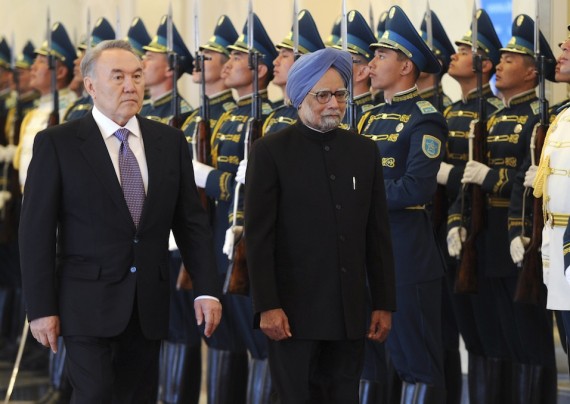Can the U.S. and India Cooperate in Central Asia?
More on:

As the U.S. moves toward military withdrawal from Afghanistan, will its commitment to continental Asia slide too?
My latest "DC Diary" column in India’s leading financial daily, the Business Standard, argues that the question is important to both the United States and India. It matters to Washington because Americans have other interests in Central Asia, quite apart from prosecuting the war. It matters to India because Central Asian governments will have fewer strategic options if the U.S. simply fades away.
Here’s the central reality: U.S. withdrawal from Afghanistan will mean a reduced footprint in Central Asia. But the United States certainly doesn’t have to disappear. And the U.S. and India, too, have some shared strategic interests, not least in facilitating the reconnection of Central Asia to the world economy.
As I’ve noted before (including on this blog), Central Asia was once integral to the Silk Road and the great caravan trade. But in the 17th century, it was pushed to the fringes of global commerce when the marginal cost of maritime trade dropped below the cost of continental trade. And as I’ve mentioned in prior blog posts, World Bank research shows that, today, landlocked countries, such as those in Central Asia, can face a growth deficit as high as 1.5 percentage points because transaction and other costs are so high.
That’s bad because Central Asian countries, with the exception of Kazakhstan, remain fragile and sometimes volatile. So infrastructure and market linkages are essential to bolster opportunities for growth. And diversifying transit links from one (trans-Russia) to two (trans-China), to three (trans-Caspian), to four (trans-South Asia) directions on the compass would also reduce Central Asia’s vulnerability to political and economic pressure from a single source.
In fact, that’s just where the U.S. and India can make a difference. Central Asians aim to broaden their partnerships beyond immediate neighbors. Surely, then, Washington could work with India, among many others, to assume a greater role as a facilitator of diversified foreign investments in the region.
The good news is that India has taken some interest in transcontinental links within Eurasia. But Washington and New Delhi inevitably bump up against two central constraints:
One is the lack of a sustainable India-Pakistan trade and transit regime.
The other is the degree to which India looks to Iran as its point of entry and exit to and from Central Asia.
Just take the reconnection of power lines: Central Asia has significant seasonal electricity surpluses and the potential to develop thousands of megawatts in new capacity. Its hydroelectric potential is particularly tempting. And gas and coal resources add to that capacity.
For its part, South Asia needs energy to fuel its economic expansion. Electricity demand is rising in both India and Pakistan. And while the Kyrgyz Republic has, for example, historically earned about one U.S. cent per kilowatt hour on power sold northward, Pakistan’s generation costs have averaged about 5 cents while India’s cost for peaking power may double even that.
The opportunities would be considerable if countries could cooperate to develop the right infrastructure and investment regime. But the state of India-Pakistan relations sets obvious constraints on the idea of moving Central Asian hydropower not just to Afghanistan and Pakistan but to India through coordinated purchase and supply arrangements and a reconnected grid.
So, too, does Iran remain a constraint on regional opportunities. The ancient Silk Road ran to Persia. But Tehran’s noncompliance with nuclear safeguards agreements and defiance of UN Security Council resolutions virtually guarantee that Washington will oppose enhanced linkages.
The U.S. and India can do much together. For one, they need to develop a shared strategic understanding of Central Asia. Continental Asia has been an arena for U.S.-India disagreement, even rancor. So a candid, if sometimes painful, discussion of what a post-American Afghanistan means for Central Asia is needed, and soon.
And the U.S. and India can cooperate in more tangible ways too. India already hosts many students from Central Asia and its programs complement U.S. strengths through India’s own English-language educational offerings. By working with India—or even co-funding Central Asian students to study in India—the U.S. could supplement its own offerings, promote Central Asia’s linkages with India, and strengthen the U.S.-India partnership.
Washington and New Delhi have every reason to multiply one another’s strengths in Central Asia through enhanced strategic coordination. The ultimate test will be to promote economic linkages and continental trade, but coordinated project finance, trade, aid, and investment policies would be a good place to start.
More on:
 Online Store
Online Store
